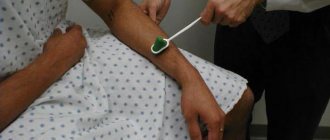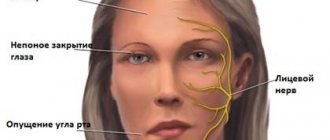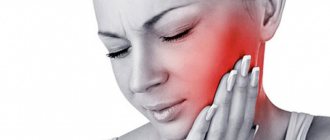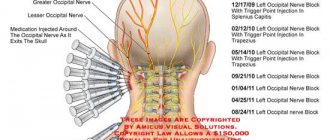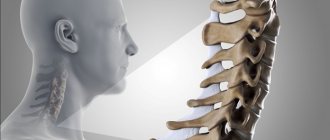Causes of the disease
Birth trauma is a pathological condition characterized by damage to tissues and organs in a newborn during childbirth, which is accompanied by disruption of their functions.
Traumatic injuries become possible when the size of the child does not correspond to the birth canal, during the provision of manual or instrumental assistance or cesarean section. They are also recorded in post-term pregnancy, large fetal mass, malformations, anomalies of presentation, vacuum extraction, narrow maternal pelvis, exostoses and old age of the postpartum woman.
Erb-Duchenne palsy occurs when the spinal cord is damaged at the C5 and C6 level or the superior brachial plexus.
Erb-Duchenne palsy occurs in newborns due to birth trauma, with traction on the arm, head, pelvis or leg of the fetus.
In this case, a rupture, tear, tension in the trunks of the brachial nerve plexus may occur, as well as rupture of the scalene muscles, fascia, and bleeding may occur.
After some time, scar formation occurs around the nerve plexus of the brachial column, causing secondary compression of the plexus, disrupting the conduction of nerves, disrupting blood circulation and the formation of neuromas inside the trunk.
Erb-Duchenne palsy is a disease that occurs in stages, in three stages during which the nerve is restored. The first stage is the acute period of injury (from birth to one month of the child’s life), the second stage is the recovery period (from a month to a year), and the third stage is residual effects (from a year).
Symptoms and course of the disease
The clinical picture of Erb-Duchenne palsy depends on the degree of damage to the nerve fibers. In any case, there is a violation of the innervation of the muscles that raise the shoulder above the horizontal line, the muscles that rotate the shoulder outward. The affected arm is usually extended in all joints and is tightly attached to the child's body. In this case, there is no movement in large joints, there are no tendon reflexes in the affected arm. Sometimes there is a groove between the shoulder and chest as a result of misalignment of the affected arm. In this case, they talk about the “doll hand” symptom.
The most severe cases of upper paralysis involve the higher segments of the cervical spine, the fourth, and sometimes the third. In this case, damage to the phrenic nerve may occur, and breathing disorders are added to the clinical picture, which can in some cases be life-threatening for the newborn.
Treatment of the disease
Diagnosis and treatment of Duchenne-Herb's palsy by orthopedic doctors, neurologists and neurosurgeons. Treatment of paralysis, depending on the severity of the disease, can be surgical or conservative combined with physiotherapeutic procedures.
Conservative treatment of Erb-Duchenne palsy occurs in stages and begins immediately after the birth of the child. Treatment is long-term using various techniques. First of all, the injured limb is immobilized using a removable splint.
The splint is used for a year and is removed only in case of hygiene measures and medical procedures. In severe cases of this disease, the splint is used during the first three years of the child’s life, and is used only at night.
The treatment complex for Erb-Duchenne palsy also includes drug therapy, massage of the injured limb, physiotherapeutic procedures and activities (electrical stimulation of the arm muscles), passive therapeutic exercises, acupuncture and reflexology.
If the child does not noticeably improve the functionality of the affected arm within the first six months, surgical correction is usually indicated.
In the most severe cases of this disease, neurosurgical operations may be prescribed, which are performed on the nerve plexuses, and orthopedic operations on bones, muscles and joints.
In severe untreated cases, they resort to surgical treatment - muscle transplantation or arthrodesis of the shoulder joint; the latter intervention is performed in children no earlier than 10-32 years of age.
When operating on the shoulder joint, surgeons use arthroscopy. This is a new surgical method that allows operations to be performed using optical fiber.
Any surgical intervention is carried out using endoscopic devices, which ensures minimal trauma, is easily tolerated by patients, speeds up the rehabilitation period and significantly reduces the risk of complications. Throughout the rehabilitation period, specialists continue to monitor their patients and help carry out the necessary exercises and procedures.
Causes
Many patients whose brachial plexus was damaged during childbirth know about this problem from their parents, but still do not know how to restore the strength of the arm muscles and relieve certain pains.
Most traumatologists recognize that paralysis occurs as a result of osteoarticular injuries (“Traumatology and Orthopedics”, edited by G.S. Yumashev). What is this mysterious damage? Some of them may be real fractures, but in most cases, these are banal subluxations of the cervical vertebrae.
As is known from anatomy, the vertebrae are normal, i.e. standing in the correct physiological position (lordosis or kyphosis), not in subluxation, their bodies form rounded channels in cross-section on both sides. In each canal, a neurovascular bundle or radicular nerve passes without interference, which, merging with its own kind, forms the brachial plexus.
Now let's imagine what will happen to this canal if the vertebrae move towards each other at a slight angle, i.e. subluxation or stasis will occur. The canal becomes curved, its cross-section is no longer round, but slit-like and begins to compress the nerve roots. Thus, negative conditions are created for the functioning of the brachial plexus, up to complete disruption or even so-called peripheral paralysis.
Diagnosis of the disease
To diagnose Erb-Duchenne palsy, the child is examined by an orthopedist and a neurologist. They also collect anamnesis, which should contain information about the course of pregnancy and childbirth.
To obtain additional information, additional research methods are used: ultrasound examination of the shoulder joint and cervical spine, computer myelography, electromyography, magnetic resonance imaging, vascular Dopplerography of the brain and spinal cord, dynamometry, electroneuromyography, rheovasography and radiography.
Diagnosis of Duchenne-Erb's palsy
Duchenne-Erb's palsy requires accurate diagnosis to determine treatment tactics. Diagnosis in Israel is carried out using radiography, electromyography, and cerebrospinal fluid examination. Modern computerized equipment used by Israeli specialists makes it possible to quickly identify the disease and select effective treatment. Prospective research practiced at the Top Ichilov Clinic is a success among many medical centers around the world. The Top Ichilov Clinic provides services for not only comprehensive, but also specialized diagnostics. To carry out the latter, doctors with narrow specializations are involved, this allows us to consider the problem much more deeply. Methods for diagnosing Duchenne-Erb's palsy used at the Top Ichilov Clinic:
- electromyography
- electroradiography
- positron emission tomography + computed tomography
- Magnetic resonance imaging (without penetration)
- transcranial magnetic stimulation
- electroencephalography
- cerebrospinal fluid puncture
- ultrasonography.
- 5
- 4
- 3
- 2
- 1
(15 votes, average: 3.9 out of 5)
Prices
| Disease | Approximate price, $ |
| Prices for diagnosing migraine | 7 060 — 8 260 |
| Prices for diagnosing childhood epilepsy | 3 100 — 4 900 |
| Prices for brain shunting for hydrocephalus | 33 180 |
| Prices for treatment of Parkinson's disease | 58 600 |
| Prices for migraine treatment | 9 680 |
| Prices for the diagnosis of amyotrophic lateral sclerosis | 6 550 |
| Prices for diagnosing epilepsy | 3 520 |
| Prices for rehabilitation after a stroke | 78 300 — 82 170 |
| Prices for treatment of childhood epilepsy | 3 750 — 5 450 |
| Prices for treatment of multiple sclerosis | 4 990 — 17 300 |
| Disease | Approximate price, $ |
| Prices for diagnosing childhood arthritis | 2 000 — 3 000 |
| Prices for diagnosing childhood epilepsy | 3 100 — 4 900 |
| Prices for pediatric neurosurgery | 30 000 |
| Prices for treatment of childhood epilepsy | 3 750 — 5 450 |
| Prices for treatment of umbilical hernia in children | 9 710 |
| Disease | Approximate price, $ |
| Prices for hip replacement | 23 100 |
| Prices for clubfoot treatment | 25 300 |
| Prices for Hallux Valgus treatment | 7 980 |
| Prices for knee joint restoration | 13 580 — 27 710 |
| Prices for scoliosis treatment | 9 190 — 66 910 |
| Prices for knee replacement | 28 200 |
| Prices for treatment of intervertebral hernia | 35 320 — 47 370 |
| Disease | Approximate price, $ |
| Prices for pediatric neurosurgery | 30 000 |
| Prices for craniotomy | 43 490 — 44 090 |
Treatment of Erb-Duchenne palsy. Exercise therapy
It is better to combine exercise therapy with massage, alternating exercises. It is important that there are no jerks or rough quick movements. You can use everything from therapeutic gymnastics exercises except hanging and traction. Laying with a splint. Treatment from the very first days should be positioning the newborn's arm using a splint in the so-called. "voting" pose. The arm is moved away from the body and bent at the elbow so that the forearm and hand are pointing upward. The baby's hand is fixed to the splint with an ordinary gauze bandage, not tightly, but also so that there is no movement. In this case, an elastic bandage should not be used to avoid pinching the blood vessels of the hand. You can place a roller in the fist or wrap the hand around the splint with your fingers straight and your thumb retracted. See the fixation of the newborn's hand to the splint in the photo. Fixation is usually carried out for several hours a day on the recommendation of a doctor. While the rest of the treatment is ongoing, the splint will need to be used, possibly for several months.
Massage for newborns with birth paralysis (obstetric)
The cause of peripheral obstetric paralysis is damage to the nerve plexuses during childbirth (stretching or rupture). Clinical manifestations depend on the level of damage.
Upper Erb-Duchenne palsy
Paralysis occurs when the nerve fibers coming from the fifth and sixth cervical segments (brachial nerve) are damaged.
It is detected during the newborn period and is characterized by loss of innervation of the deltoid, bi- and triceps, brachial muscles, supinator, teres minor, infraspinatus, supraspinatus, and serratus anterior muscles. The affected limb is extended in all joints, brought to the body, internally rotated in the shoulder and forearm, and the hand is bent. Tendon reflexes are not evoked. There is no movement in the shoulder and elbow joints, but the fingers and hand are preserved.
With age, if preventive measures are not taken, a subluxation forms in the shoulder joint, the arm hangs under the influence of gravity and appears longer than the healthy one. This paralysis is often combined with torticollis due to injury to the GCM.
Dejerine-Klumpke palsy
Occurs in newborns when nerve fibers coming from 7-8 cervical segments and 1-2 thoracic segments are damaged. In this case, the function of the muscles of the forearm and hand is impaired - the function of the flexors of the hand and fingers is lost. At birth, the symptom of “fin hands” is immediately noticeable - the fingers are not clenched into a fist, but straightened and retracted to the ulnar side, the thumb is pressed to the palm.
Damage to the lumbar enlargement
They occur during childbirth when the pelvic end of the fetus is pulled, the artery of the lumbar enlargement (artery of Adamkiewicz) is damaged. Motor disorders occupy a leading place - this is lower paraparesis.
During the neonatal period. 1) such a baby lies like a frog - the feet are turned out, the legs are slightly bent at the knees and sluggishly scattered; 2) there is no support reaction - the most important symptom, and therefore automatic gait fails; 3) the Bauer crawling reflex is absent.
After 2-3 months, trophic disorders develop - muscle loss, asymmetry of the folds on the hips, buttocks - a “deflated ball”.
Delays in physical development appear at 6-7 months - the child cannot sit down on time and has difficulty supporting his legs. Later, when walking, the baby quickly gets tired (asks to be held), his legs become weak and flat feet develop.
Baby massage - mechanism of action.
Massage for newborns with birth paralysis is a kind of passive gymnastics for the affected muscles and nerves. This is relevant for children, because due to existing impairments, they cannot fully perform active gymnastics, which would help eliminate the impairments. Therefore, nerve impulses coming from the massaged muscles replace the impulses that should enter the spinal cord from active movements. The receipt of such positive impulses into the spinal cord is a necessary condition for the complete restoration of innervation (normalization of the conduction of nerve impulses from the spinal cord to the muscles and back).
By restoring impaired blood supply to the affected limbs, children's massage helps improve trophic processes, preventing muscle atrophy.
Under the influence of massage, muscles and ligaments are strengthened, and gradually the limbs acquire the ability for active movements, this makes it possible to combine children's massage with active gymnastics, which increases the training load on the body, and therefore, it works more, and this increases the volume and strength of the muscles. Therefore, with systematic treatment, improvement and complete restoration of motor functions can be achieved.
Related links:
Massage for a child with birth trauma
Flatten head
Course of the disease
Obstetric paralysis gradually progresses, so it is recommended to begin a course of therapy immediately after the first signs of injury are detected. The disease is characterized by the following stages:
- Acute stage. It lasts from 4-5 hours to 2-3 days after injury. During this period of time, the patient cannot bend his arm at the elbow joint or does it with difficulty. The damaged shoulder freezes in one position, and the fingers on the same limb become inactive;
- Recovery stage. It lasts for an extremely long time and even with well-designed treatment, this period takes about 3 years. During this time, the swelling will gradually decrease and, to the extent possible, blood circulation in the injured limb will be restored. Over time, a person gradually begins to move paralyzed muscles, and the extent to which this ability will return depends on the injuries received;
- Stage of residual effects. It is characteristic of most neurological pathologies. People who previously suffered from Duchenne and Erb's palsy may have residual contracture (tightening) of the shoulder. This stage is also characterized by deformation of the scapula, which manifests itself in the form of changes in shape and location. Sometimes there are abnormal rotational (circular) movements in the forearm and contracture when bending the arm at the elbow. In more rare cases, the patient still has minor difficulties in flexing the fingers and hand on the injured limb.
According to statistics, the most residual effects remain in the following cases:
- With a serious rupture of the nerve plexus;
- Due to intoxication;
- In case of infection.
If the problem affects an adult, then it is often not possible to completely restore lost sensitivity. In children, the situation is better in this regard, since tissue healing occurs much faster in them, but there is a chance that one arm will be shorter than the other.
Features of the clinical picture
The symptoms of the pathology will depend on the severity of damage to nerve fibers and disturbances in the conduction of nerve impulses.
In children with this disorder, manifestations of paralysis are clearly visible. First of all, constant anxiety will be noticeable due to the pain of the injury. Also among the main symptoms are:
- decreased muscle tone;
- inflexibility of the arm in the elbow joint;
- the injured arm twists in an unnatural way;
- breathing is weak;
- the fist of the injured hand is clenched with the thumb bent;
- the skin on the hand may turn pale and become cold;
- pressing the injured arm to the body;
- lack of response to stimuli.
Despite the fact that the damaged arm becomes practically inactive, the hand joint and fingers make movements of low intensity.
The photo shows a child with Duchenne Erb's palsy


